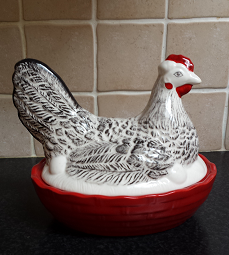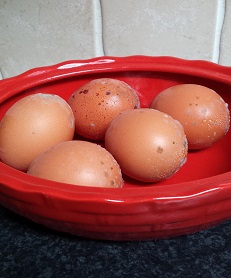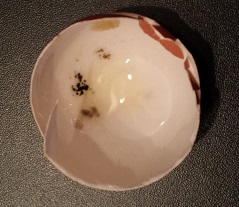
Hen container for eggs
I’m back to blogging after a short time away in Edinburgh. It was a few days of mixed emotions. I gave the eulogy at my mother’s funeral on Friday the 11th of March then two days later watched Scotland beat France in a great victory at Murrayfield. Returning to Ireland and checking my rainfall meter, showed that there was no rain whilst I was away. We’ve not had any rain since, which makes it 14 days rain free and a welcome break from all the wet weather of the past 3 months. Easter is arriving this weekend and thinking of eggs, I thought a few ‘foustie’ ones would be of interest. A dilemma I had was on which article to post first. This one about eggs, or, my previous one on chickens.
Keeping eggs in a fridge or a cupboard
The picture above is of our container for holding eggs. We keep our eggs in a fridge and take some out as needed to fill the container to have eggs handy at room temperature. This is something we have done for a long time and I cannot remember why we bring the eggs to room temperature. A vague memory says it has to do with the yolks not breaking so easily when cracked open. Many years ago when we started using our “hen” container, on one occasion the eggs had fungus growing all over their shells.
Eggs, moisture and fungus
So why had fungus grown on the eggs? At the time it happened I worked out a reason based on temperature and humidity. Obviously eggs taken from the fridge are cold and when put into the “hen” container will chill the inside air around the eggs. As I explain in the first chapter of my eBook “A Wet Look At Climate Change”, cooling air increases the relative humidity. And, as I explain in a later chapter, once the relative humidity gets above a certain level, this allows fungi to grow. Of course, the shell of the eggs provides a nice source of nutrients for the fungi to help it grow. Not to waste food by repeating the same mistake, we have since had a protocol to prevent fungal growth. Eggs from the fridge are put into the “hen” container with the lid left off for a few hours until the eggs have warmed to room temperature. Then the “hen” lid is put on top and the container placed in a kitchen cupboard.
Our egg protocol has worked over the years to provide us with fungus-free eggs. That is until a couple of weeks ago. Hopeful of a fry-up on a Sunday morning I took the “hen” lid off to find six fungus covered eggs.

Fungus growing on eggs
I took a photo this time, which is the one above of eggs in the bowl of the “hen” container. Two possibilities, either the eggs were not warmed up enough, which I doubt, or high ambient humidity, after weeks of wet weather, allowed fungus to grow. Moist air from outside coming into the house did build up over a long period of regular storms. Heating generally keeps the humidity level comfortable for living in, due to the relationship of a higher temperature and its effect of lowering the %RH. But, eventually moisture levels do increase and will remain high until it is removed by dehumidification, or escapes to the outside as moist air is replaced by drier weather.
To eat or not to eat
Unfortunately, the six foustie eggs were the only ones we had and I was really looking forward to that fry-up. What else could a man do but crack open the eggs and have a look, and a sniff inside!

Fungus on the inside of the egg shell
The fungus which was probably penicillium, the same type as you get on bread, had penetrated through the hard shell. The egg inside looked fine and passed the sniff test. Taking a guess that the mycelium of the fungus had not penetrated the membrane below the hard shell, we cooked the eggs, had a great fry-up, and, still here to tell the tale!
If you would like to hear more about moisture in everyday life, please subscribe to my blog.
Welcome to my world of moisture!

1 Pingback